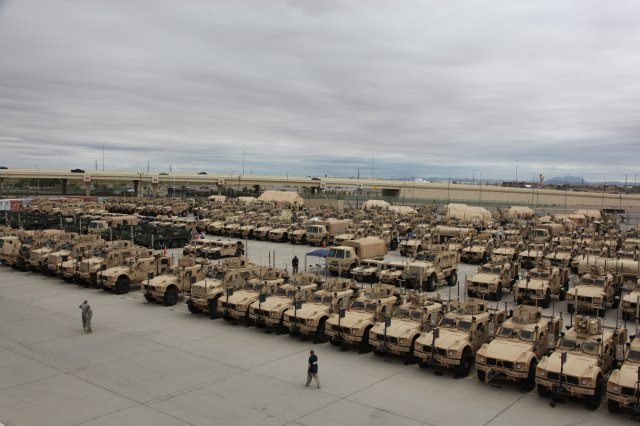In preparation for the Army’s Network Integration Evaluation 13.1, the System of Systems Integration Directorate, with support from the Army Test and Evaluation Command, the Brigade Modernization Command and the 2nd Brigade Combat Team, 1st Armored Division, kicked off a four-week-long network validation exercise, last month.
Designed to “load” the network throughout the brigade and set the stage for developers and brigade staff to validate its functionality, each week-long portion of the network validation exercise, known VALEX, incorporates an increased number of systems and Soldiers from the previous week, and greater evaluation intensity.
“During VALEX, we stand up every node and every vehicle in order to do a connectivity check,” said Col. Gail Washington, Project Manager Current, System of Systems Integration Directorate, or SoSI. “We’re doing a lot of integration work, along with shooting satellite signals to Aberdeen Proving Ground and Fort Gordon, which is the regional hub. We’re also running validation threads which will allow us to pass position location information, calls for fire, send an email and various other communication tasks.”
Three hundred sixty-one vehicles including mine-resistant, ambush-protected all-terrain vehicle, or M-ATV, variants, Bradleys, Strykers, Abrams Tanks, Scout vehicles, Humvees and Light Weight Tactical Vehicles have been integrated for NIE 13.1. “We have touched every type of vehicle that’s in the Army inventory for this iteration,” said Washington.
During the Planning Phase of VALEX, network requirements were defined and designed using Information Exchange Requirements prioritized by Department of the Army objectives, TRADOC capability gaps and system objectives. During the Preparation Phase known as LOADEX, or loading exercise, the systems underwent various hardware and software integration.
“The whole intent of VALEX is to make sure the pieces are communicating,” said Alex Gonzales, 1st Battalion, 35th Armored Regiment trail boss. “The end state for us is to hand off a 100 percent integrated network to the brigade combat team so that every piece of equipment is communicating with platoon, company and battalion, all the way up to the brigade level. We’re testing radios at the platoon level to ensure everyone at the platoon level is talking and knows each other’s position location at the dismount level through the use of handheld radios and up so the people in the vehicles are able to see where all their Soldiers are on the battlefield.”
Gonzales is one of seven “trail bosses” selected to support NIE 13.1. The trail bosses are a group of Army Acquisition Officers who serve as a link between 2/1 AD and the acquisition, training and test communities. They develop and lead a team of engineering, logistics, test, information assurance, resource management and combat development personnel responsible for management of planning, synchronizing and integrating multiple systems under test and evaluation into units participating in the NIEs.
The trail boss role is critical to the NIE process because these officers provide subject matter expertise and advice to their supported unit on the integration, issue, training, operation, maintenance and employment of the systems being evaluated in the NIEs.
In the Execution Phase, 2/1 AD will operate the network with all systems configured and tested at the individual system level. These tests will be conducted during the Brigade’s Garrison COMMEX, or communication exercise, and will be scheduled as independent company, battalion headquarters and brigade headquarters events.
“We’re loading roughly 1,800 systems during VALEX,” said Lt. Col. Keith Taylor, with Product Manager Capability Package Integration, SoSI and 2/1 AD trail boss. “The integration work is intense. Everyone thinks about the major systems involved in each NIE, but they don’t realize we have to install, integrate and validate every radio on every system undergoing test and evaluation prior to the evaluation.”
To complete this integration, approximately 600 cables have been produced and recorded, totaling roughly 1.2 miles of cabling with various connectors on both ends. Many of the cables used for NIE 12.2 are being reused for NIE 13.1.
Following the integration work, the network will be handed over to the unit for a Garrison COMMEX.
“During Garrison COMMEX, the first week in October, we’re going to turn everything off and then the unit will bring it back up to make sure the network is functional and running as it should,” said Washington. “The Soldiers will run various tests on the systems under evaluation and systems under test and if they find a problem, they are issued a trouble ticket and a Field Service Representative is dispatched to help trouble shoot the problem. This ensures these bugs are worked out prior to taking the systems out to the field during the NIE.”
As was done for the previous NIEs, Army engineers are conducting significant up-front integration at Fort Bliss, Texas in order to decrease the integration burden on 2/1 AD Soldiers during 13.1 operations at White Sands Missile Range, N.M.
The four-week-long NIE will begin mid-October and will be conducted by the 3,800 Soldiers of 2/1 AD. NIE 13.1 will conduct several program tests for record, additional tests for record from distributed sites, and less formally evaluate more than 20 industry and government capabilities. NIE 13.1 will help establish an early look at the Capability Set 14 network baseline, building upon the CS 13 network architecture that was validated during NIE 12.2 in May and June 2012.










